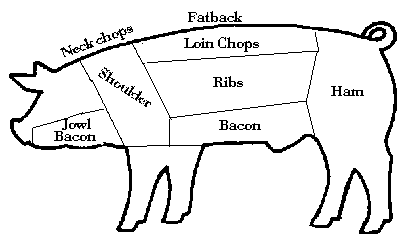
Today, I am presenting a recipe that seems to be rather flawed. However, it is so delicious that I feel it deserves some mention. My original intention was to make this . I have been reading a lot of Orangette. The writing is just so good, and the stories are really entertaining. The recipes that are featured really appeal to me. I especially liked the idea of a rich chocolate cake like this one, but then I came across a similar recipe in one of my cookbooks. This second recipe uses fewer eggs and less sugar, so I figured it would be less filling, but it would taste richer.
As the cake came out of the oven, it smelled delicious. However, it looked a little dry. When it came time to serve dessert, the cake proved to be dryer than I would have liked, though there were pockets of moist (how I hate that word), rich cake. It was really similar in texture to a brownie, but the flavor was more sophisticated than most brownies I have tasted. While it crumbled apart and was impossible to eat with anything but a spoon, it was undeniably delicious.
My belief is that the temperature of my oven is off, and the delicate nature of this cake could not properly endure the extra heat. As a result,the cake was slightly overcooked. I intend to buy an oven thermometer to prevent future problems like this one.
At some point, I would like to try this cake again, in order to perfect the texture. If this doesn't work, then I will turn to the Orangette recipe above. The extra eggs should prevent dryness in this type of cake. And so, though I have ideas on how to fix this problem (and it really is worth it!), the cost of ingredients and the calories of the recipe discourage me from remaking it right away. When I do, however, I promise to tell you about it. Does anyone else have thoughts on how the cake could be less crumbly?
I have reprinted the original recipe below.
Charlie's Afternoon Chocolate Cake
reprinted from Chocolate Ephiphany by Francois Payard.
Ingredients:
Vegetable cooking spray, for the pan
All-purpose flour, for the pan
10 tablespoons unsalted butter
8 oz. (usually two bakers' chocolate bars) 60% chocolate, chopped
2 large eggs
2/3 cup of sugar
3/4 cup all purpose flour
Place a rack in the center of the oven and preheat the oven to 350 degrees. Spray the sides and bottom of a round 9-inch cake pan with cooking spray. Dust with flour, shaking off the excess, and set aside.
Bring the butter to a boil in a medium saucepan over medium-high heat. Stir to prevent from burning. Remove from the heat and add the chocolate to the pan. Stir the mixture until the chocolate is melted and smooth
Whisk together the eggs and sugar in a large bowl, until well-combined. Add the flour and mix well. Add the chocolate to the batter and stir until the mixture is just combined. Pour the batter into the prepared cake pan.
Bake for 15 minutes, then lower the heat to 300 degrees and bake for an additional eight minutes. Remove the cake from the oven and allow it to cool completely in the pan. Unmold, and serve.
Makes one 9 inch cake; serves eight to ten.
Serve with whipped cream, ice cream, or powdered sugar, if desired. This cake freezes well.






















